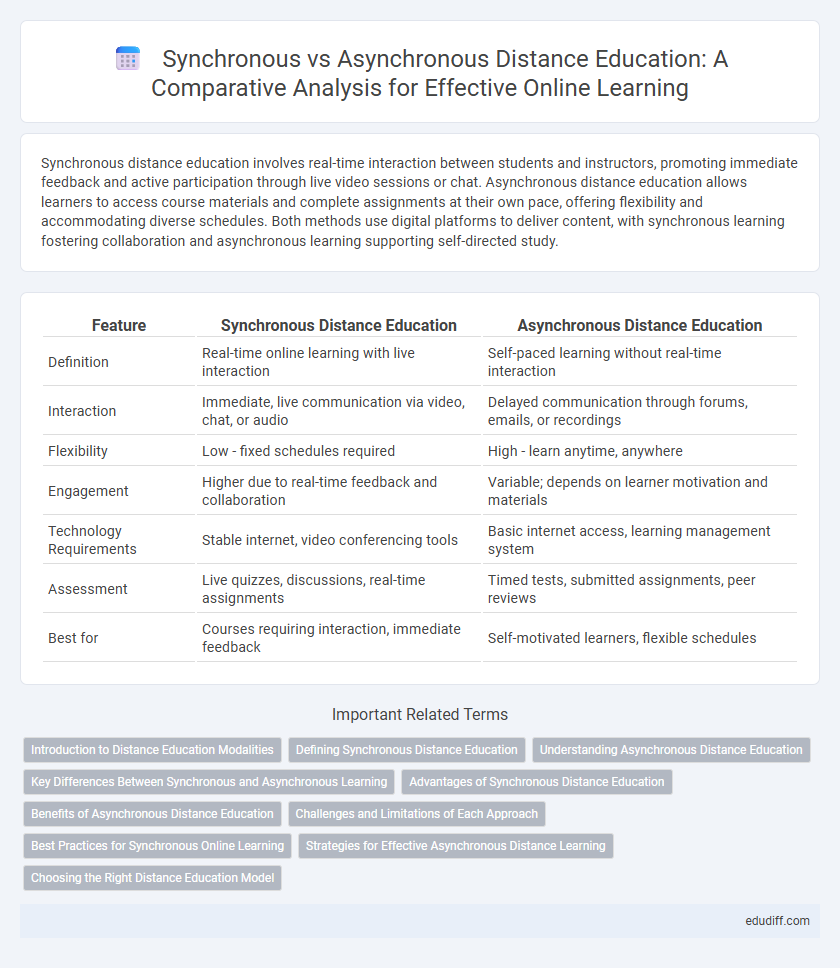Synchronous distance education involves real-time interaction between students and instructors, promoting immediate feedback and active participation through live video sessions or chat. Asynchronous distance education allows learners to access course materials and complete assignments at their own pace, offering flexibility and accommodating diverse schedules. Both methods use digital platforms to deliver content, with synchronous learning fostering collaboration and asynchronous learning supporting self-directed study.
Table of Comparison
| Feature | Synchronous Distance Education | Asynchronous Distance Education |
|---|---|---|
| Definition | Real-time online learning with live interaction | Self-paced learning without real-time interaction |
| Interaction | Immediate, live communication via video, chat, or audio | Delayed communication through forums, emails, or recordings |
| Flexibility | Low - fixed schedules required | High - learn anytime, anywhere |
| Engagement | Higher due to real-time feedback and collaboration | Variable; depends on learner motivation and materials |
| Technology Requirements | Stable internet, video conferencing tools | Basic internet access, learning management system |
| Assessment | Live quizzes, discussions, real-time assignments | Timed tests, submitted assignments, peer reviews |
| Best for | Courses requiring interaction, immediate feedback | Self-motivated learners, flexible schedules |
Introduction to Distance Education Modalities
Synchronous distance education involves real-time interaction between instructors and students through video conferencing, live chat, or virtual classrooms, enabling immediate feedback and active participation. Asynchronous distance education allows learners to access course materials, recorded lectures, and discussion forums at their own pace, offering flexibility and accommodation for diverse schedules. Both modalities utilize digital platforms and learning management systems (LMS) to facilitate remote learning and enhance educational accessibility.
Defining Synchronous Distance Education
Synchronous distance education involves real-time interaction between instructors and students through platforms such as video conferencing, live chats, or virtual classrooms. This method facilitates immediate feedback, active participation, and a structured learning schedule, mimicking traditional classroom dynamics. Technologies like Zoom, Microsoft Teams, and Google Meet are commonly used to deliver synchronous learning experiences.
Understanding Asynchronous Distance Education
Asynchronous distance education allows learners to access course materials, lectures, and assignments at their convenience, promoting flexibility and self-paced study. This mode utilizes platforms such as Learning Management Systems (LMS), discussion forums, and recorded video lectures to facilitate learning without real-time interaction. Understanding asynchronous distance education involves recognizing its role in supporting diverse learning schedules and fostering independent knowledge acquisition through delayed communication.
Key Differences Between Synchronous and Asynchronous Learning
Synchronous distance education requires real-time interaction between instructors and learners, utilizing live video lectures, instant messaging, or virtual classrooms, which fosters immediate feedback and collaboration. Asynchronous distance education allows learners to access materials, complete assignments, and engage with content independently at their own pace, providing flexibility but limiting instant communication. The key differences focus on timing of participation, interaction level, and scheduling flexibility, with synchronous learning emphasizing simultaneous engagement, while asynchronous learning prioritizes convenience and self-directed study.
Advantages of Synchronous Distance Education
Synchronous distance education offers real-time interaction, enabling immediate feedback and dynamic discussions that enhance student engagement and comprehension. This format supports structured schedules, fostering a consistent learning environment that mirrors traditional classroom settings. It also facilitates collaborative activities and instant clarification of doubts, improving knowledge retention and learner motivation.
Benefits of Asynchronous Distance Education
Asynchronous distance education offers flexible learning schedules, enabling students to access course materials and complete assignments at their own pace, which accommodates diverse time zones and varied personal commitments. This mode enhances deep learning by allowing time for reflection and repeated review of content without the pressure of real-time interaction. Furthermore, asynchronous education can increase accessibility for learners with limited internet bandwidth or unreliable connections, as materials can be downloaded and viewed offline.
Challenges and Limitations of Each Approach
Synchronous distance education faces challenges such as rigid scheduling, limited flexibility for students in different time zones, and dependency on reliable internet connectivity, which can hinder real-time interaction. Asynchronous distance education struggles with delays in communication, potential feelings of isolation, and difficulties in maintaining student motivation and engagement without immediate feedback. Both approaches require robust technological infrastructure and self-discipline, but synchronous methods emphasize real-time interaction limitations, while asynchronous formats highlight engagement and communication delays.
Best Practices for Synchronous Online Learning
Effective synchronous online learning relies on real-time interaction tools such as video conferencing, live chat, and collaborative whiteboards to enhance student engagement and immediate feedback. Employing structured schedules, clear communication guidelines, and interactive activities promotes active participation and minimizes distractions during live sessions. Incorporating breakout rooms and polls fosters group collaboration and dynamic assessment, optimizing the synchronous distance education experience for diverse learner needs.
Strategies for Effective Asynchronous Distance Learning
Effective asynchronous distance learning strategies include creating clear, structured course materials that allow students to progress at their own pace while fostering engagement through interactive forums and multimedia content. Regular instructor feedback via email or recorded videos enhances motivation and clarifies concepts, bridging the gap of delayed communication inherent in asynchronous formats. Utilizing learning management systems with analytics helps track student progress and tailor support, optimizing learning outcomes in asynchronous distance education.
Choosing the Right Distance Education Model
Synchronous distance education enables real-time interaction between instructors and students, fostering immediate feedback and active engagement, which is crucial for courses requiring hands-on collaboration or instant clarification. Asynchronous distance education offers flexible scheduling, allowing learners to access materials and complete assignments at their own pace, ideal for working professionals or those balancing multiple commitments. Selecting the right distance education model depends on factors like course content complexity, learner availability, and desired interaction level to maximize educational outcomes.
Synchronous Distance Education vs Asynchronous Distance Education Infographic

 edudiff.com
edudiff.com